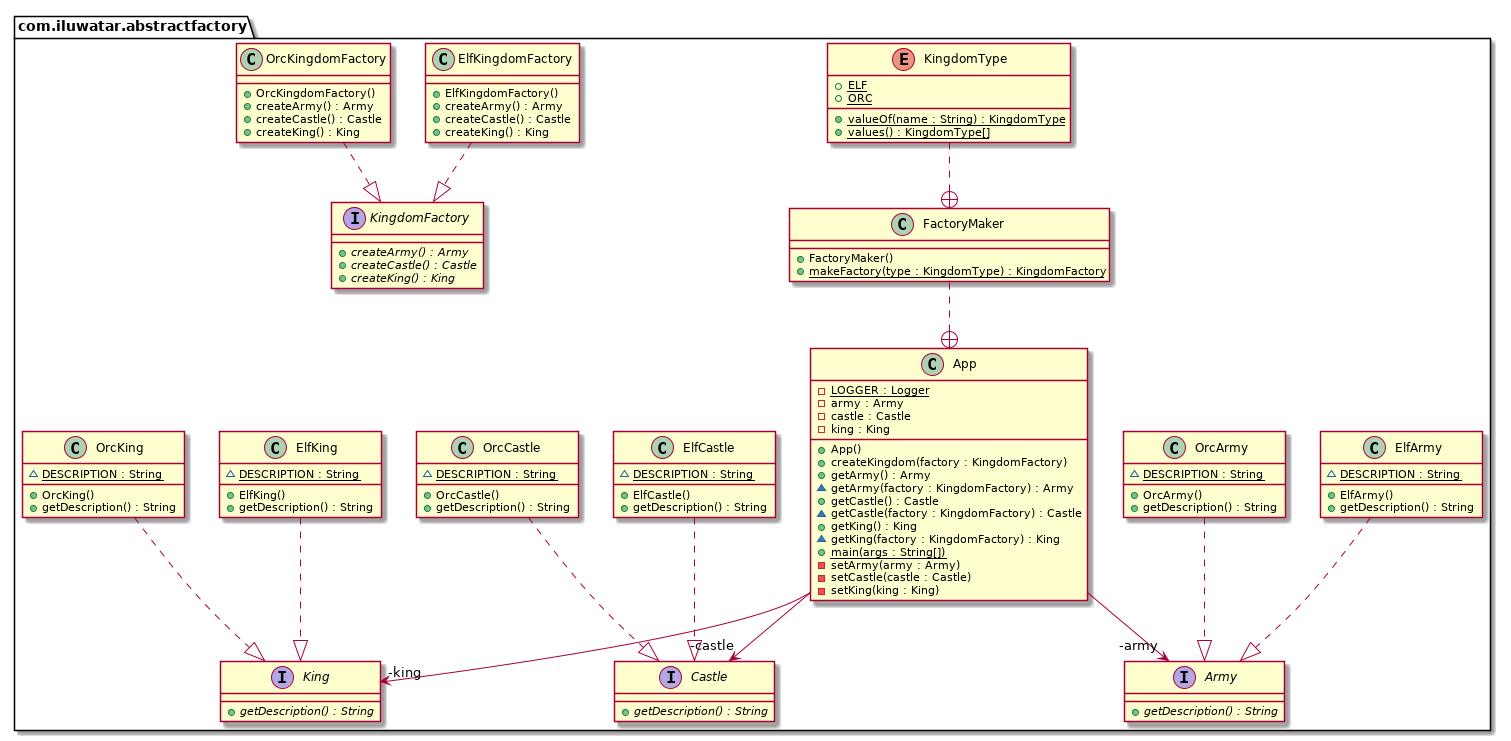Abstract Factory
Also known as
Kit
Intent
The Abstract Factory design pattern provides a way to create families of related objects without specifying their concrete classes. This allows for code that is independent of the specific classes of objects it uses, promoting flexibility and maintainability.
Explanation
Real-world example
To create a kingdom we need objects with a common theme. The elven kingdom needs an elven king, elven castle, and elven army whereas the orcish kingdom needs an orcish king, orcish castle, and orcish army. There is a dependency between the objects in the kingdom.
In plain words
A factory of factories; a factory that groups the individual but related/dependent factories together without specifying their concrete classes.
Wikipedia says
The abstract factory pattern provides a way to encapsulate a group of individual factories that have a common theme without specifying their concrete classes
Programmatic Example
Translating the kingdom example above. First of all, we have some interfaces and implementation for the objects in the kingdom.
public interface Castle {
String getDescription();
}
public interface King {
String getDescription();
}
public interface Army {
String getDescription();
}
// Elven implementations ->
public class ElfCastle implements Castle {
static final String DESCRIPTION = "This is the elven castle!";
@Override
public String getDescription() {
return DESCRIPTION;
}
}
public class ElfKing implements King {
static final String DESCRIPTION = "This is the elven king!";
@Override
public String getDescription() {
return DESCRIPTION;
}
}
public class ElfArmy implements Army {
static final String DESCRIPTION = "This is the elven Army!";
@Override
public String getDescription() {
return DESCRIPTION;
}
}
// Orcish implementations similarly -> ...
Then we have the abstraction and implementations for the kingdom factory.
public interface KingdomFactory {
Castle createCastle();
King createKing();
Army createArmy();
}
public class ElfKingdomFactory implements KingdomFactory {
@Override
public Castle createCastle() {
return new ElfCastle();
}
@Override
public King createKing() {
return new ElfKing();
}
@Override
public Army createArmy() {
return new ElfArmy();
}
}
public class OrcKingdomFactory implements KingdomFactory {
@Override
public Castle createCastle() {
return new OrcCastle();
}
@Override
public King createKing() {
return new OrcKing();
}
@Override
public Army createArmy() {
return new OrcArmy();
}
}
Now we have the abstract factory that lets us make a family of related objects i.e. elven kingdom factory creates elven castle, king and army, etc.
var factory = new ElfKingdomFactory();
var castle = factory.createCastle();
var king = factory.createKing();
var army = factory.createArmy();
castle.getDescription();
king.getDescription();
army.getDescription();
Program output:
This is the elven castle!
This is the elven king!
This is the elven Army!
Now, we can design a factory for our different kingdom factories. In this example, we created FactoryMaker, responsible for returning an instance of either ElfKingdomFactory or OrcKingdomFactory. The client can use FactoryMaker to create the desired concrete factory which, in turn, will produce different concrete objects (derived from Army, King, Castle). In this example, we also used an enum to parameterize which type of kingdom factory the client will ask for.
public static class FactoryMaker {
public enum KingdomType {
ELF, ORC
}
public static KingdomFactory makeFactory(KingdomType type) {
return switch (type) {
case ELF -> new ElfKingdomFactory();
case ORC -> new OrcKingdomFactory();
};
}
}
public static void main(String[] args) {
var app = new App();
LOGGER.info("Elf Kingdom");
app.createKingdom(FactoryMaker.makeFactory(KingdomType.ELF));
LOGGER.info(app.getArmy().getDescription());
LOGGER.info(app.getCastle().getDescription());
LOGGER.info(app.getKing().getDescription());
LOGGER.info("Orc Kingdom");
app.createKingdom(FactoryMaker.makeFactory(KingdomType.ORC));
--similar use of the orc factory
}
Class diagram

Applicability
Use the Abstract Factory pattern when
- The system should be independent of how its products are created, composed, and represented
- The system should be configured with one of the multiple families of products
- The family of related product objects is designed to be used together, and you need to enforce this constraint
- You want to provide a class library of products, and you want to reveal just their interfaces, not their implementations
- The lifetime of the dependency is conceptually shorter than the lifetime of the consumer.
- You need a run-time value to construct a particular dependency
- You want to decide which product to call from a family at runtime.
- You need to supply one or more parameters only known at run-time before you can resolve a dependency.
- When you need consistency among products
- You don’t want to change existing code when adding new products or families of products to the program.
Example use cases
- Selecting to call to the appropriate implementation of FileSystemAcmeService or DatabaseAcmeService or NetworkAcmeService at runtime.
- Unit test case writing becomes much easier
- UI tools for different OS
Consequences
Benefits
Flexibility: Easily switch between product families without code modifications.
Decoupling: Client code only interacts with abstract interfaces, promoting portability and maintainability.
Reusability: Abstract factories and products facilitate component reuse across projects.
Maintainability: Changes to individual product families are localized, simplifying updates.
Trade-offs
Complexity: Defining abstract interfaces and concrete factories adds initial overhead.
Indirectness: Client code interacts with products indirectly through factories, potentially reducing transparency.
Tutorials
Known uses
- javax.xml.parsers.DocumentBuilderFactory
- javax.xml.transform.TransformerFactory
- javax.xml.xpath.XPathFactory